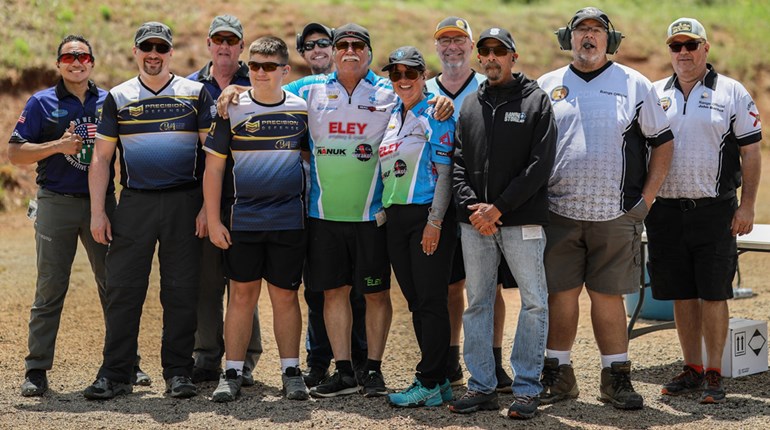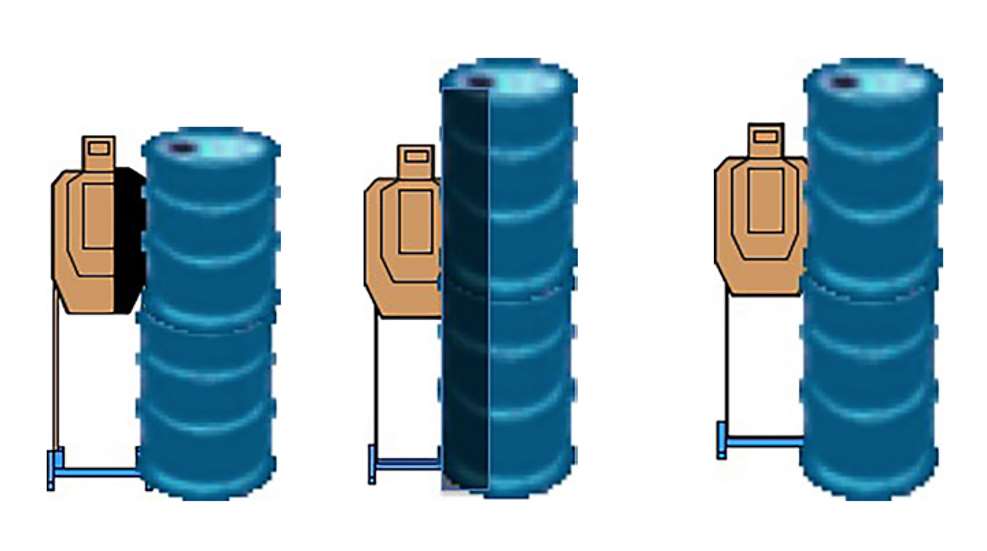
While attending matches and teaching classes, one of the most common scoring issues I find is how barrel strikes and other potential shoot-through situations are handled. In some areas of the country if a bullet skims or bounces off a barrel, it is scored as a Mike; in other areas, they treat any shoot-through of a barrel as a good hit even if there is no indication the barrel is designated soft cover. This article will discuss three key issues:
- How barrels should be treated.
- Practical hints on stage construction to solve some of the scoring issues.
- How barrel strikes should be scored to actually follow the rules.
For some parts of the country, the use of barrels in lieu of building vision barriers or walls is a common practice. Some clubs have large quantities of plastic and metal barrels. They are easily stored outside and in many cases the barrels are simple to move and set up. (More on that later.) However, if they become badly shot up or damaged, it is harder for Range Officers to score around them. I have seen a few clubs wrap the barrels in kraft paper as an easy way to use pasters to cover any holes. This technique does not work well in the rain. (A Wisconsin Sectional several years ago comes to mind.)
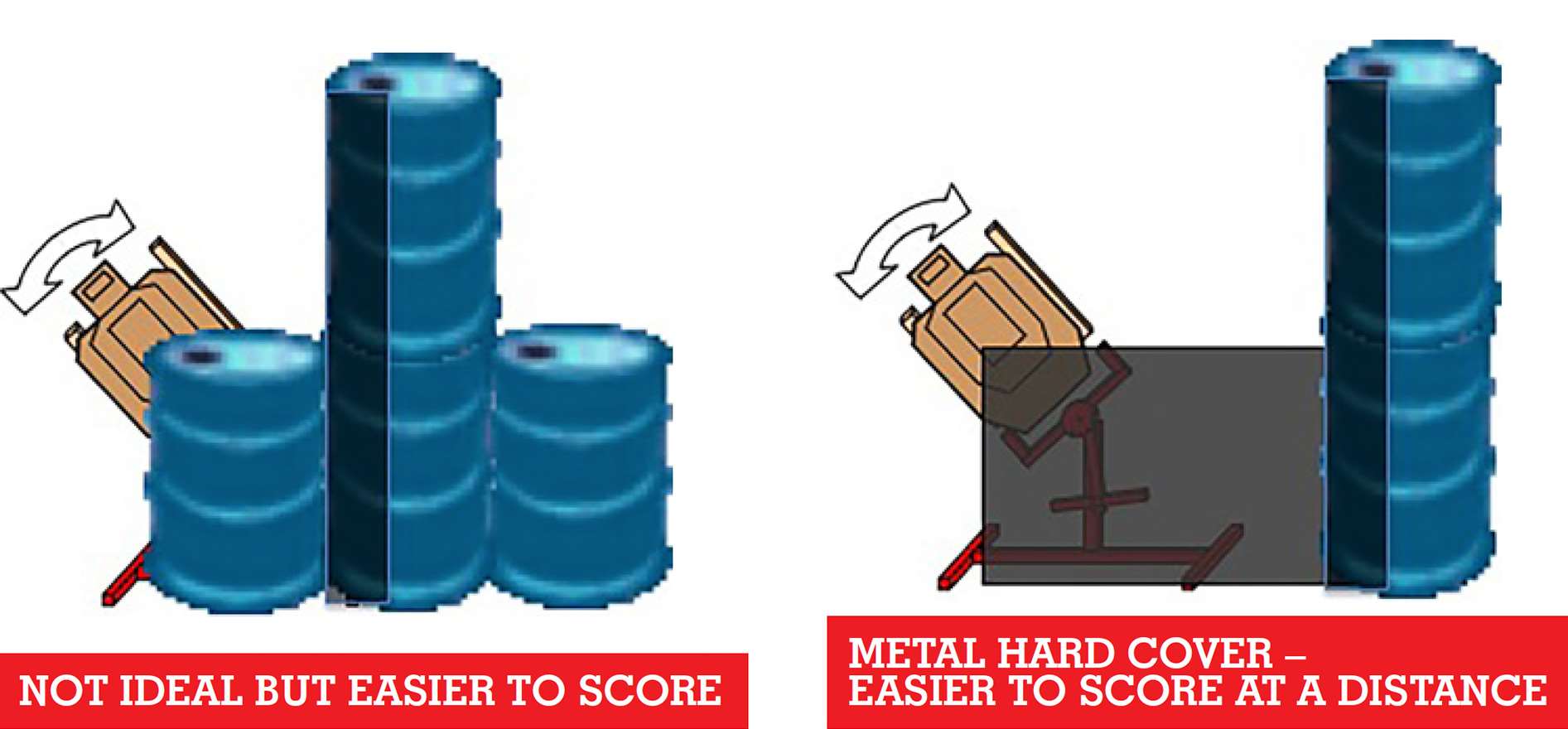
Under USPSA rules, all barriers are hard cover unless designated otherwise. Obviously, barrels are barriers under Rule 2.2.3.3 and are hard cover by default. Still, there are clubs who have decided that all barrels are soft cover for whatever reason. There are two problems with this. First, if a competitor shoots at clubs where the barrels are treated differently, they may be confused. Second, and to me more importantly, if you designate barrels as soft cover it encourages people to shoot through them. After a while, the barrels will become basically useless and even unsafe. Getting struck by a bullet which has entered a barrel and is deflected back to the shooter can be unsettling at best and dangerous at the worst.
If your club has access to a large supply of new or used barrels it might not be an issue, but a situation like that is not common. Sometimes barrels can be found at a reasonable price, but the transportation costs are often prohibitive. As such, we should strongly discourage the use of barrels as soft cover.
Stage Design and Set-Up Using Barrels
For many cases, we can take steps in stage design and set-up to limit the potential for shoot-throughs of barrels to make scoring easier. One of the easiest ways is to use hard-cover targets in close proximity to the barrels to encourage the competitor to aim away from the barrel during engagement. During the 2020 USPSA Single Stack/L10-Revolver Nationals, any targets in close proximity to the barrels had hard-cover targets associated with them to make scoring easier.
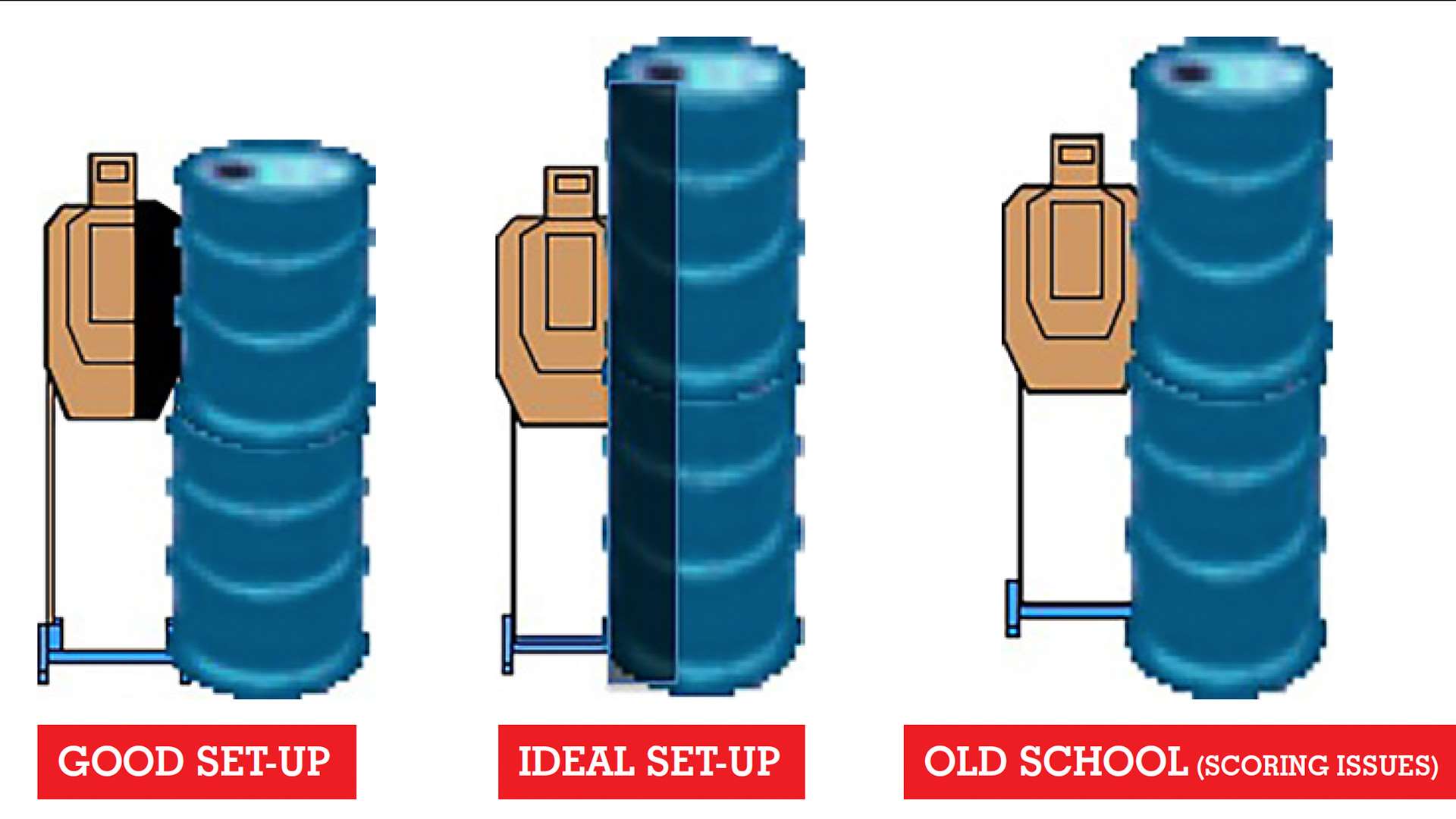
Another tip is to use black paint on the side of the barrel to again encourage the competitor to aim away from the barrel. It also makes repairs easier in the case of a hit barrel. In combination with a hard-cover target, this will really cut down on barrel strikes and subsequent scoring issues.
With the exception of indoor shooting, any time you place barrels in a course-of-fire, make sure the barrel is anchored down to the ground. This will prevent any accidental movement from someone bumping into it or the wind. Also, if you are using barrel stacks make sure the barrels are secured to each other in some manner. This can be as simple as placing three equidistant screws to secure the upper barrel to the lower barrel, or using 1x2 splints to secure the stacks together. My preference is the first method, because if during the match you need to adjust the barrel due to damage, it is easier to rotate the top barrel, rather than pull the spikes and attempting to rotate the barrel stack as a unit. At a recent match, I ended up rotating the top barrel every morning because of multiple bullet strikes. Eventually, especially with plastic barrels, the barrel will become so deformed by multiple hits that the amount of target available will change enough to be noticeable.
In this case, we were painting hits between shooters and then covering the holes and gouges with black duct tape. The tape started to build up enough that it became difficult to see any subsequent strikes. This is particularly true if you do not cut away the plastic that ends up sticking up due to bullet paths or just exits in the plastic. We simply rotated the barrel about a quarter turn and we had a clean barrel surface to start each day. We were careful to make sure the presentation was as close to the same as possible before starting the first squad in the morning. (Taking a picture with your phone from each shooting position is like gold in these cases.)
Another common use for barrels is to screen moving targets and activators. There will be potential for a competitor to follow the target behind the barrels, and you must have some method to make sure the hits on the target did not pass through the barrel. A close examination of both the barrel and the target may simplify these calls, but be aware this may happen especially if the moving target is at distance. For these cases, it is better to use actual physical hard cover or steel.
A common problem I have seen is some stages use a barrel at the end of a wall section to force shooters farther away from the wall. This is to prevent the wall edges from being shot up. If you do that, make sure there is no gap between the wall edge and the barrel(s). This may give the competitor the false illusion that that is a port they can shoot through to engage targets. If that was not your intent, make sure you secure the barrels or place them in a position so it is clear that was not the intent of the design. I have seen lazy set-up cause all kinds of issues because of this.
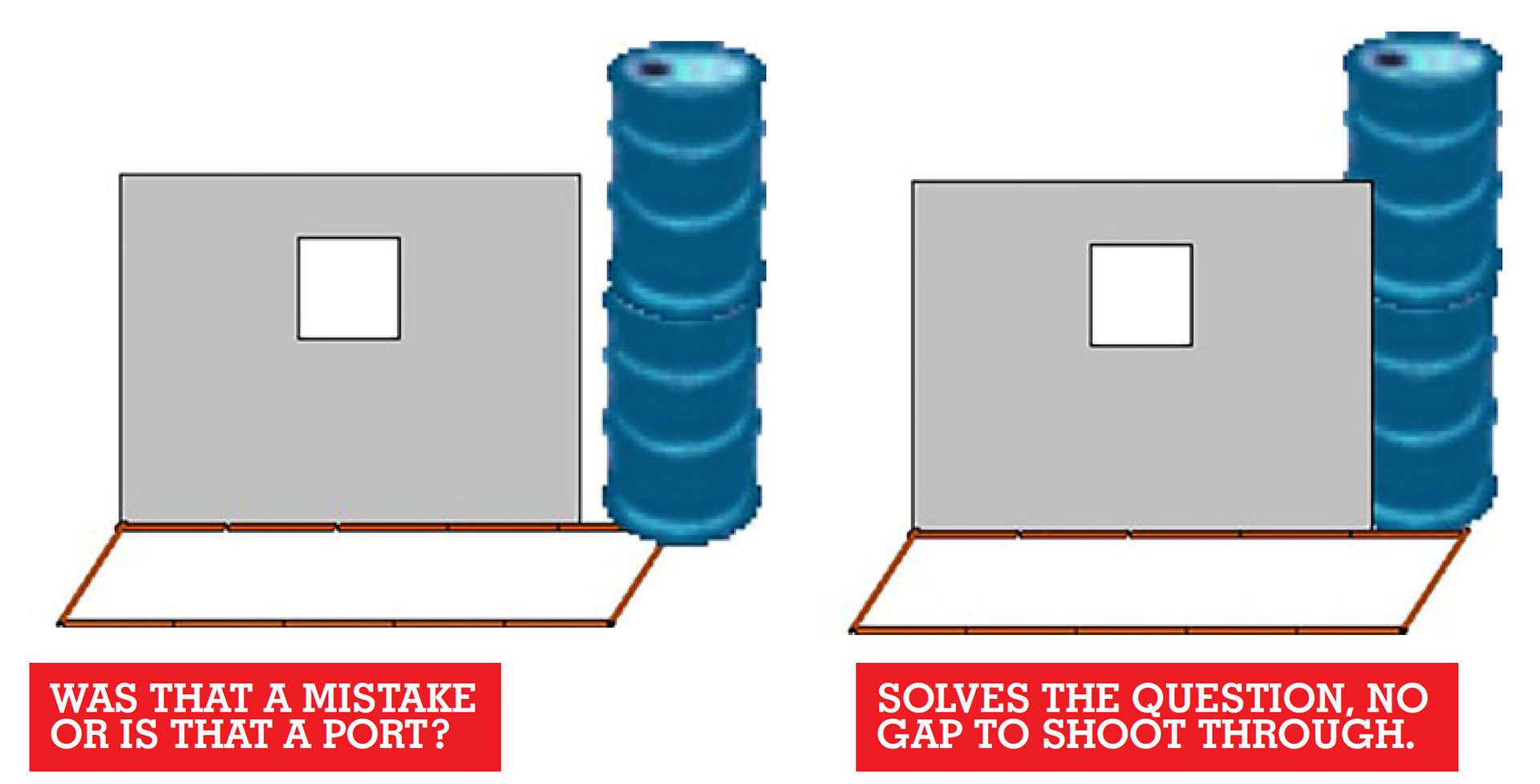
Scoring Barrel Hits, Bounces and Glancing Blows
If there is anything scored more inconsistently than barrel strikes, I do not know of it. At a number of clubs around my area, if your bullet hits a barrel, whether is a full-diameter strike or just a glancing blow it is scored as a Mike. The rationale goes back to the mis-interpretation of Rule 9.5.5. Thus, if a competitor bounces a bullet off the side of a plastic barrel and it diverts the bullet into a target it is a miss, right?
Let’s examine the USPSA rules that apply. Rules 2.2.3.3 and 2.2.3.4 state that all barriers are hard cover unless they are designated in the Written Stage Briefing as soft cover (see Rule 9.1.6). So let’s look at Rule 9.1.6 and its sections.
If a bullet strikes wholly within the hard cover and continues on to strike a cardboard target it will not score. If it again strikes wholly within hard cover and continues to hit a plate or strike down a popper it will be treated as range equipment failure and a reshoot will be ordered.
Okay, so far so good. If a competitor actually shoots through the barrel, the rule is cut and dry. The hit will either not score, or if it hits a metal target and causes it to fall it will cause a reshoot.
Where the “if it hits a barrel, it does not score” crowd falls down is the following two rules. If the hit on the hard cover is a partial, i.e. does not pass wholly through the hard cover, any hit downrange will score on cardboard and metal target whether scoring or penalty type targets.
Scoring: Three Scenarios
1. You walk up to the barrel and there is an obvious bullet hole in the barrel, and when you go to the target there is a hole in a part of the target that is not visible from the position it was fired from unless it went through the barrel. That one is easy. I ususally look for a difference in the color of the grease (carbon) ring to confirm that is the bullet strike, but this is not necessary.
2. You walk up to the barrel and there is a partial strike or divot in the side of the barrel, and there is a bullet hole in the C zone of the downrange target. Again, easy to score as a Charlie.
3. You walk up to the barrel and there appears to be a glancing bullet strike on the barrel, and you notice a keyhole-type bullet strike in a target further downrange from the barrel, or even in a no-shoot in close proximity to the barrel. This is the type of hit that causes most issues.
Some ROs will then refer to Rule 9.5.5, which states “Enlarged holes in a cardboard target which exceed the competitors bullet diameter will not count for score or penalty unless there is visible evidence within the remnants of the hole to eliminate the presumption that the hole was caused by ricochet or splatter.” The key word is enlarged, not elongated. If a bullet tumbles because it is off-balance, for various reasons it may strike the cardboard sideways. This is often referred to as a keyholing bullet. If there is no indication it struck something in its travels, it is easily scored. However, if as in our case it struck the side of a barrel and is diverted into a target, whether in tumbles or not, it will still score as long as it was not a full-diameter hit through the hard cover.
The above is a long explanation for a simple concept. A full-diameter hit through hard cover does not score, while a partial hit does score—whether we are talking a barrel, wall or any other hard-cover barrier.
So as a range officer or chief range officer working a stage with barrels, how can you ensure you are scoring the stage consistently and fairly? First, before the match starts make sure all pre-existing bullet strikes and holes are covered using something like duct tape, not just pasters. I carry a roll of black duct tape (my preference is Gorilla Tape because it sticks even in the rain) for this purpose, and make sure all holes are covered before we begin.
During the match, you can paint any holes that occur between shooters and then come back and cover between squads. Or if you have it available, tape holes between shooters. If you start to have issues with excessive hits in a concentrated area, you may have to either rotate the barrel(s) or replace if it becomes too difficult to score. I have done this with wall edges. Beyond a certain point, you may start to see structural issues if the damage is excessive. Remember that under Rule 2.3.7, it is your responsibility to make these types of routine repairs and maintenance. At larger matches, you may call on the assistance of Mr. Fix-It or stage support. At a local match, contact the match director if you do not have either the tools or experience to perform this type of work.
Hopefully, this article will help you for working a stage with barrels, or as a competitor and someone tries to pull the “if it hit a barrel, it does not score” card. Remember, there are specific USPSA rules that cover bullet strikes and barriers. Follow these rules and it will become much easier to score these types of calls.
Article from the January/February 2021 issue of USPSA’s FrontSight magazine.
Read more: Guide To USPSA Stage Interpretation















